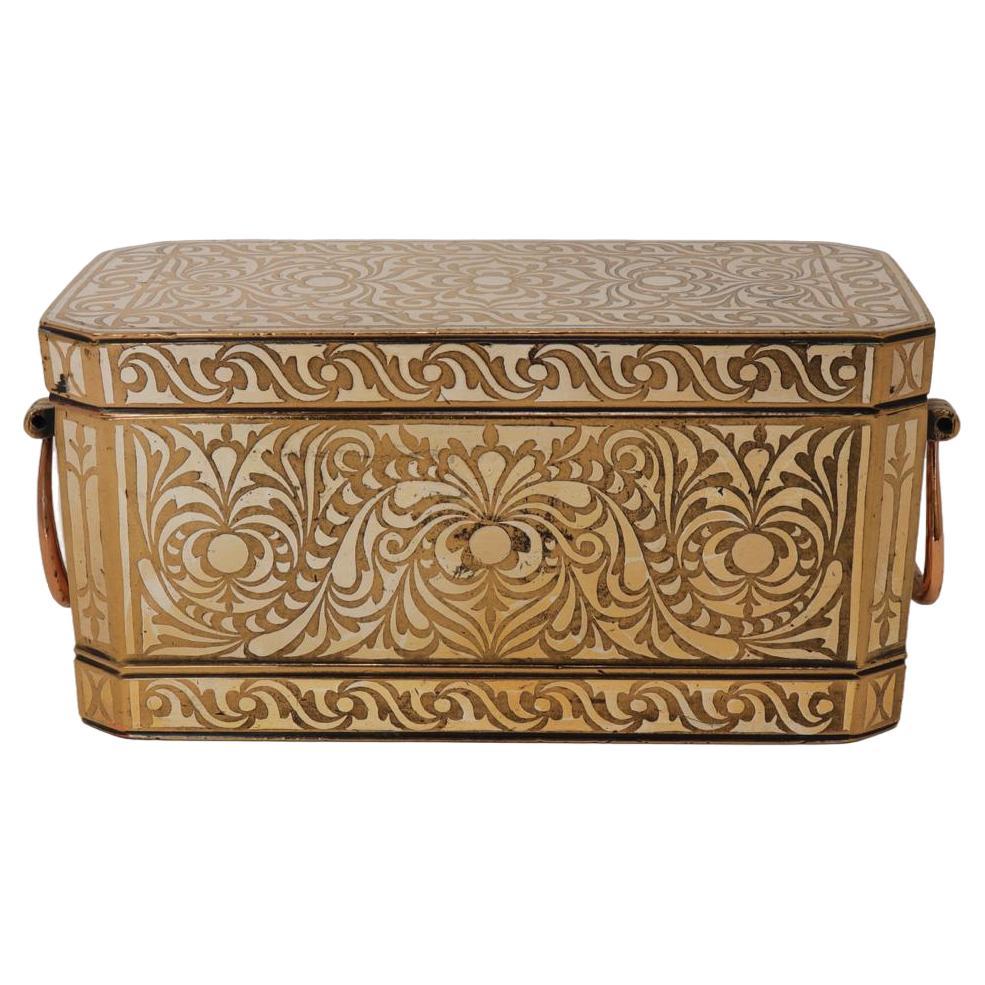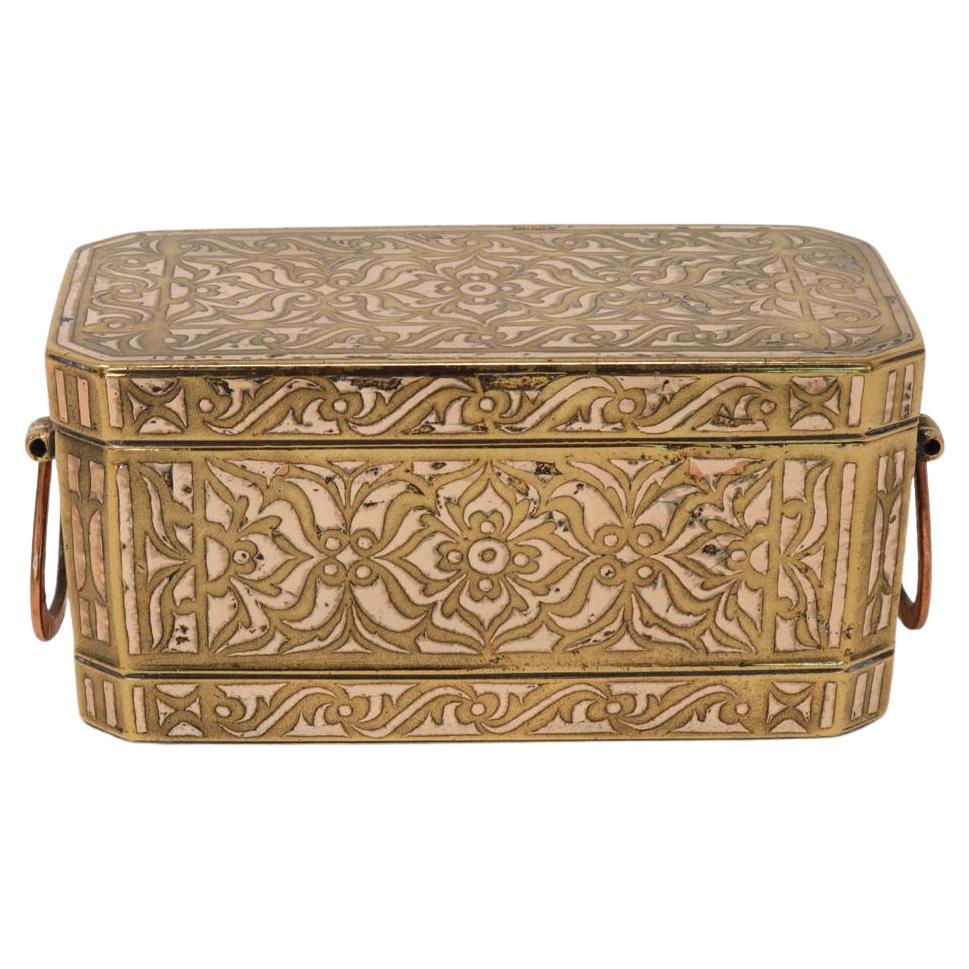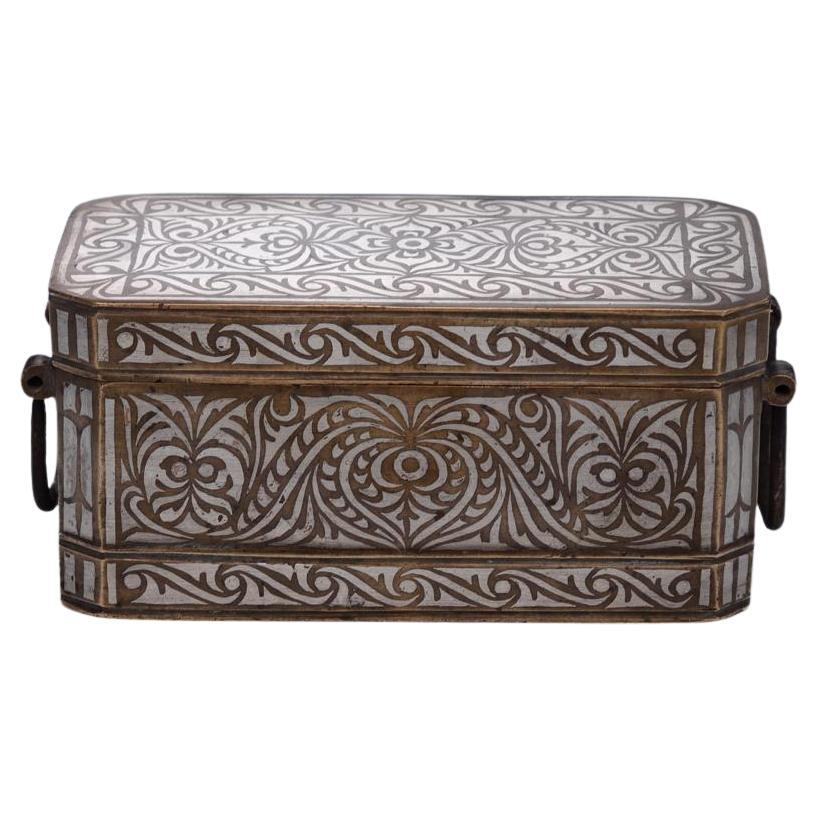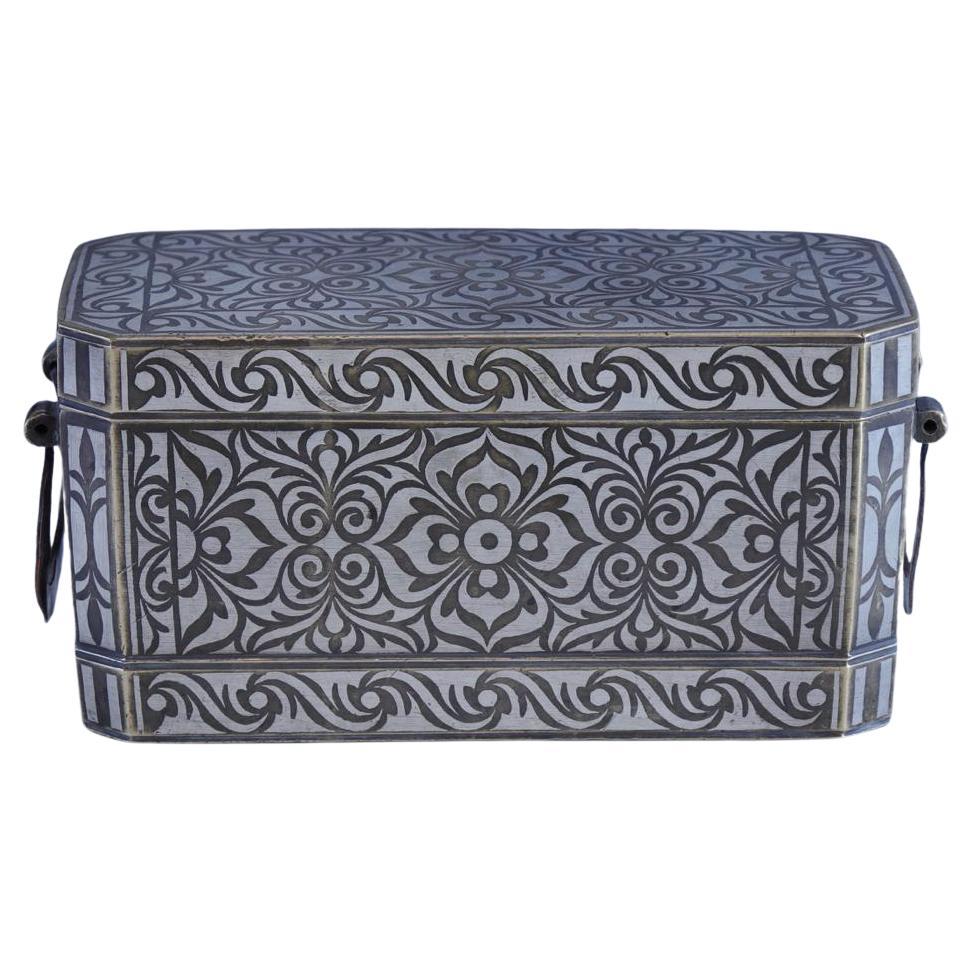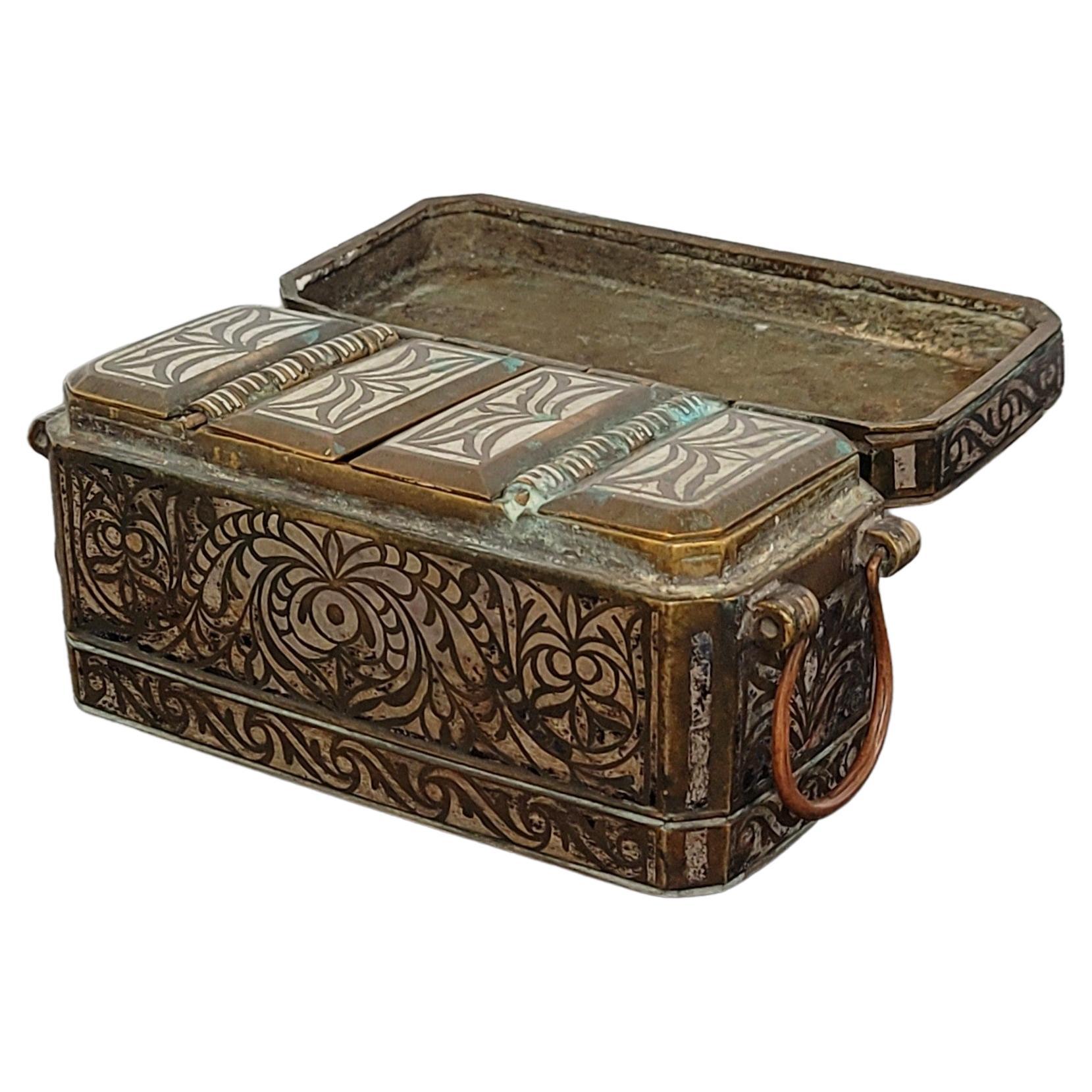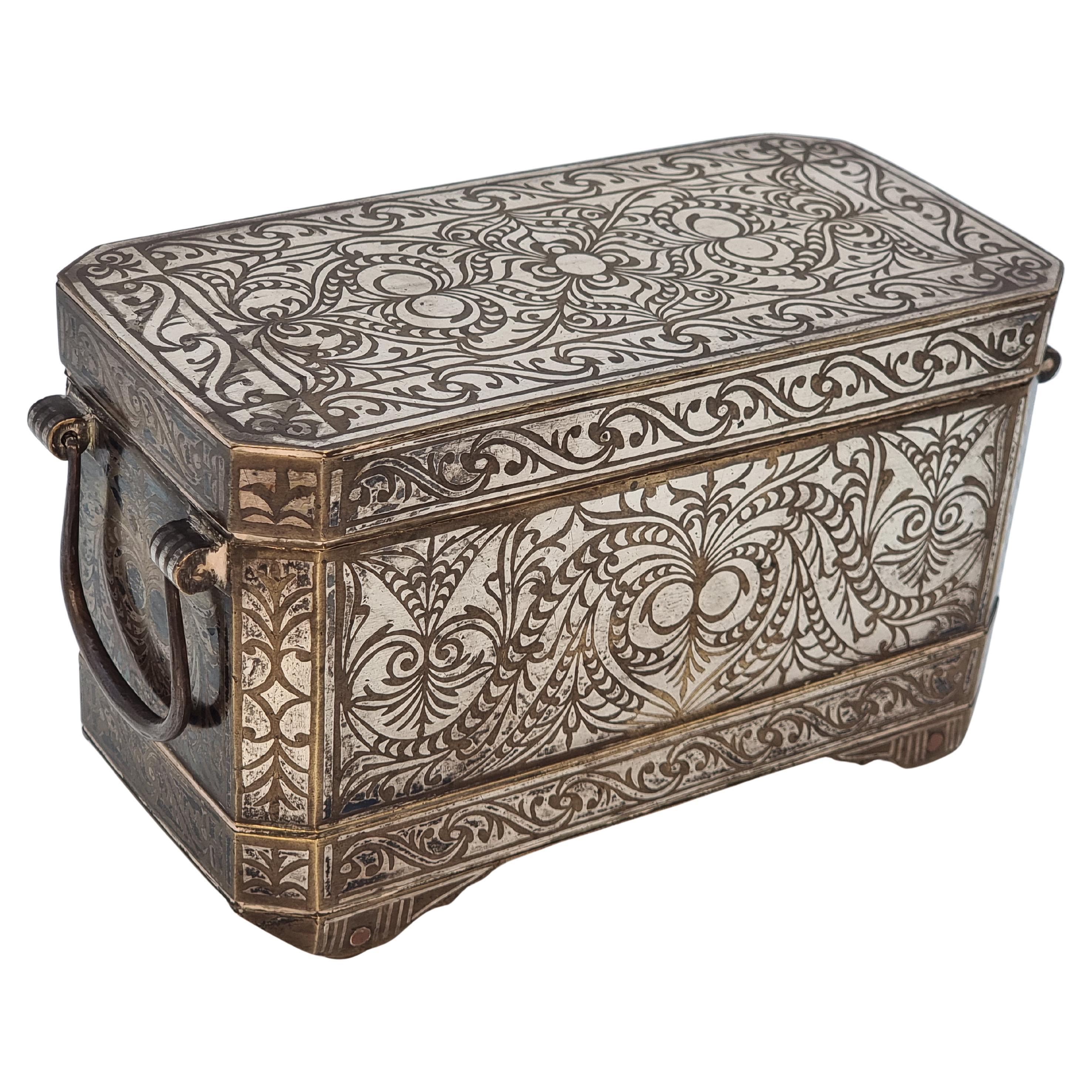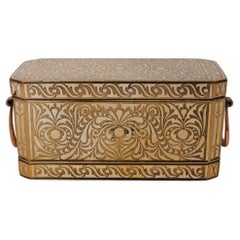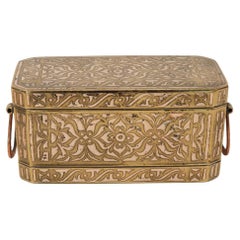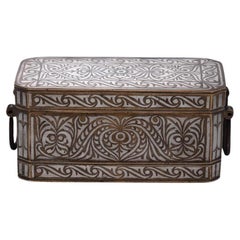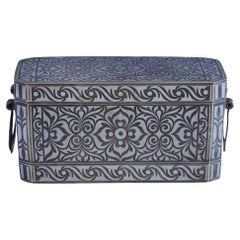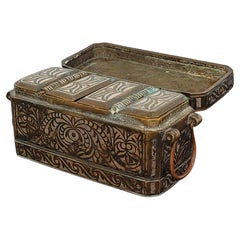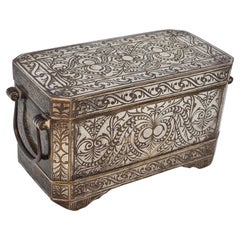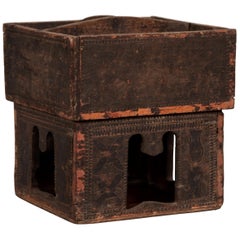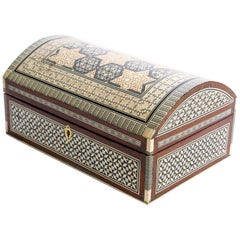Items Similar to Personal size Betel Nut Box, Maranao, Southern Philippines (Mindanao)
Want more images or videos?
Request additional images or videos from the seller
1 of 13
Personal size Betel Nut Box, Maranao, Southern Philippines (Mindanao)
$300
£229.37
€264.18
CA$420.39
A$469.33
CHF 245.92
MX$5,745.04
NOK 3,123.20
SEK 2,944.78
DKK 1,971.63
About the Item
Personal size Betel Nut Box, Maranao, Southern Philippines (Mindanao).
A mixed metal box having a brass body with bordered silver inlay design overall of a symmetrical floral tendril vine pattern referred to as “the okir pattern”, a traditional design for the Maranao people. This small betel box is a rectangular body with a hinged lid, containing three sectioned interior chambers covered with four hinged and decorated lids. One of the smaller chambers is encrusted with slaked lime. The box details include chamfered upright corners and copper looped side handles. This box was used for the storage of the betel leaf, areca nut and chewing condiments. Condition: Minor signs of age and use, otherwise fine. Measuring: 2.75 inches high x 6 inches long x 2.75 inches deep. (7 x 15.3 x 7 cm). 2 lbs. 10 oz. (1186 grams). Early 20th century.
- Dimensions:Height: 2.75 in (6.99 cm)Width: 6 in (15.24 cm)Depth: 2.75 in (6.99 cm)
- Style:Tribal (Of the Period)
- Materials and Techniques:
- Place of Origin:
- Period:
- Date of Manufacture:Early 20th century
- Condition:Wear consistent with age and use.
- Seller Location:Point Richmond, CA
- Reference Number:Seller: TM-UH900201stDibs: LU1778236980332
About the Seller
5.0
Platinum Seller
Premium sellers with a 4.7+ rating and 24-hour response times
Established in 1999
1stDibs seller since 2015
687 sales on 1stDibs
Typical response time: 2 hours
- ShippingRetrieving quote...Shipping from: Palm Springs, CA
- Return Policy
Authenticity Guarantee
In the unlikely event there’s an issue with an item’s authenticity, contact us within 1 year for a full refund. DetailsMoney-Back Guarantee
If your item is not as described, is damaged in transit, or does not arrive, contact us within 7 days for a full refund. Details24-Hour Cancellation
You have a 24-hour grace period in which to reconsider your purchase, with no questions asked.Vetted Professional Sellers
Our world-class sellers must adhere to strict standards for service and quality, maintaining the integrity of our listings.Price-Match Guarantee
If you find that a seller listed the same item for a lower price elsewhere, we’ll match it.Trusted Global Delivery
Our best-in-class carrier network provides specialized shipping options worldwide, including custom delivery.More From This Seller
View AllMedium Betel Nut Box, Maranao, Southern Philippines (Mindanao)
Located in Point Richmond, CA
Medium Betel Nut Box, Maranao, Southern Philippines (Mindanao).
Bronze/Brass with bordered silver inlay design overall of a symmetrical floral tendril vine pattern referred to as “th...
Category
Early 20th Century Philippine Tribal Metalwork
Materials
Silver, Brass
Small Betel Nut Box, Maranao, Southern Philippines (Mindanao)
Located in Point Richmond, CA
Small Betel Nut Box, Maranao, Southern Philippines (Mindanao).
A mixed metal box having a bronze/brass body with bordered silver/copper inlay design overall of a symmetrical floral t...
Category
Early 20th Century Philippine Tribal Metalwork
Materials
Silver, Brass, Copper
Small Betel Nut Box, Maranao, Southern Philippines (Mindanao)
Located in Point Richmond, CA
Small Betel Nut Box, Maranao, Southern Philippines (Mindanao).
Bronze with bordered silver inlay design overall of a symmetrical floral tendril vine pattern referred to as “the okir ...
Category
Early 20th Century Philippine Tribal Metalwork
Materials
Silver, Bronze
Large Betel Nut Box, Maranao, Southern Philippines (Mindanao)
Located in Point Richmond, CA
Large Betel Nut Box, Maranao, Southern Philippines (Mindanao).
Bronze with bordered silver inlay design overall of a symmetrical floral tendril vine pattern referred to as “the okir ...
Category
Antique 19th Century Philippine Tribal Metalwork
Materials
Silver, Bronze
Deluxe Betel Nut Box Set, Maranao Culture, Southern Philippines (Mindanao).
Located in Point Richmond, CA
Two bronze rectangular boxes decorated with symmetrical silver inlay in the tendril vine pattern referred to as “the okir pattern”, a traditional design for the Maranao people. This...
Category
Early 20th Century Philippine Tribal Metalwork
Materials
Silver, Bronze
Late 19th Century Lacquer and Bamboo Betel Box, Burma
Located in Point Richmond, CA
Betel Box, Kun It
Burma
Late 19th/early 20th century
Bamboo, lacquer
H: 7.5 in x D: 8.5 in :: 19 cm x 21.5 cm
Intricately painted motifs (including chili seed pattern, Nga Y...
Category
Antique Late 19th Century Burmese Tribal Lacquer
Materials
Bamboo, Lacquer
You May Also Like
Antique Southeast Asian Filipino Maranao Silver Inlaid Brass Betel Nut Box
Located in Forney, TX
A scarce fine quality antique silver-inlaid solid brass betel nut box (Lutuan), dating to the second half of the 19th / early 20th century, hand-crafted in Mindanao, Philippines.
Boxes such as this were used to store the areca nut (also known as the betel nut) which would be wrapped in a betel leaf with lime paste and other ingredients, often tobacco, for chewing. Similar to the European tea caddy, these boxes often served as a way to impress while showing off ones wealth.
Betel chewing was prevalent in the southern Philippines as in much of the rest of Southeast Asia. Wealthier Maranao families on Mindanao were able to afford elaborate silver-inlaid brass betel boxes such as this example. Such boxes were used to show off to guests and from which they were offered betel and the other component such as leaves and lime to make up the betel quid.
Rare large size, most extant examples of such boxes tend to measure around 5 inches in length. At slightly more than 7.75 inches the example here is larger than most.
The distinctive decorative box features a very heavy strong-box like rectangular shaped chest form with canted corners, copper handles, and a conforming hinged lid, lifting open to reveal an interior divided into three compartments covered by four hinged lids. Each of these doors is inlaid with silver in stylized orchid flower patterns.
Exceptionally executed throughout, the arabesque silver inlaid exterior is decorated to the top with a large orchid motif within scrolling obid-obid (stylized rope) borders. The front, back and sides are inlaid with sets of stylized tail feathers of the sari-manok bird beneath which are unusual, highly stylized whimsical zoomorphic faces that appear like cat or tiger faces. (Such stylisation is accounted for by Southeast Asian Islamic preferences to avoid the overt and this potentially idolatrous representation of animal and human forms. Designs such as these are drawn from a local design repertoire that has its origins in wood carving.
Although the spread of Islam in the Philippines began in the 14th century, mostly through the influence of Muslim merchants from the western Malay Archipelago, decorative arts in this design remain exceptionally rare. This lutuan represents a fine example of Islamic metalwork from the most eastern outreach of Islamic art and civilisation: Mindanao island being significantly further east than even China – artwork from Islamic Southeast Asia remains chronically under-represented in the world’s major collections of Islamic art.
PROVENANCE / ACQUISITION
Acquired from highly reputable auction house, Austin Auction Gallery, established 1983, Austin, Texas.
References
Brownrigg, H., Betel Cutters...
Category
Antique 19th Century Philippine Islamic Decorative Boxes
Materials
Silver, Brass, Bronze, Copper
A Mindanao silver inlaid bronze betal nut box, Islamic, mid to late 19th century
Located in Central England, GB
This highly decorative box is a betal nut box. The habit of chewing was relevant in the southern Philippines and much of southeast Asia. Wealthy Maraneo families on the island of Mi...
Category
Antique Late 19th Century Philippine Tribal Decorative Boxes
Materials
Silver
Antique Thai Wooden Betel Nut Box with Carved Décor and Pierced Motifs
Located in Yonkers, NY
An antique Thai wooden betel nut box from the early 20th century, with carved décor and pierced motifs. Born in Thailand during the early 20th century, this antique wooden betel nut ...
Category
Early 20th Century Thai Decorative Boxes
Materials
Wood
Handcrafted Middle Eastern Sadeli Jewelry Box
Located in North Hollywood, CA
Large exquisite handcrafted Middle Eastern Egyptian mosaic marquetry sadeli inlaid wood jewelry box.
Dome chest intricately decorated with Moorish motif des...
Category
20th Century Egyptian Moorish Jewelry Boxes
Materials
Fruitwood
Antique Brass and Copper Betel Nut Box
Located in Chapel Hill, NC
Antique Philippine Brass and Copper Betel Nut Box. The top lifts to reveal 2 hinged compartments that held the betel leaf and areca nut. Inlaid in c...
Category
Antique Late 19th Century Philippine Tribal Decorative Boxes
Materials
Brass, Copper
Antique Anglo-Indian Vizagapatam Jewelry Inlaid Sadeli Footed Box
Located in North Hollywood, CA
Antique 19th century Anglo-Indian jewelry, trinket footed box, inlay with ebony, mosaic marquetry Sadeli work and a carved Hindu scene on top.
The box case is made from sandalwood wi...
Category
Early 20th Century Indian Anglo-Indian Decorative Boxes
Materials
Bone, Mother-of-Pearl, Wood
